 |
|
|
|
|
|
#1 |
|
Guest
Posts: n/a
|
Because of the picture post limit of the board this post will be broken up into many segments.
Part 1 - Preface A few months back I did a controlled experiment to test the RH in my VinoTemp under various conditions. The purpose of the test was to demonstrate the RH swings that I notice when my unit cycles under a decent load. Since I have limited use of my thumb for a few days I will try to compile this info here. A shot of said test subject: 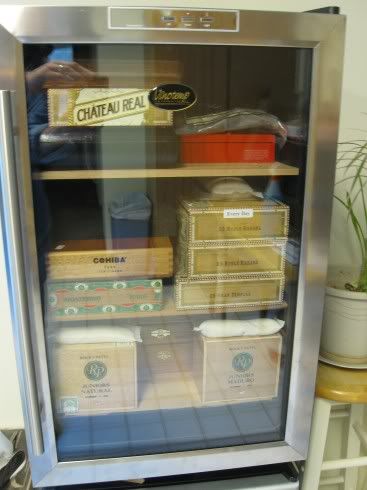 The vino is a year old, plugged in less than 1/4 of the time and maintained at a RH of 62%-66% and a temperature of 65-70 degrees. To begin with, I salt tested 1 Oregon Scientific remote unit and 4 Acu-Rite Humidity/Temperature Monitors. The main unit of the Oregon Scientific will monitor the room temperature and humidity. The remote unit will be placed inside a normal cigar box placed on the top of the middle shelf. 3 of the Acu-Riteís will also be placed inside the VinoTemp. 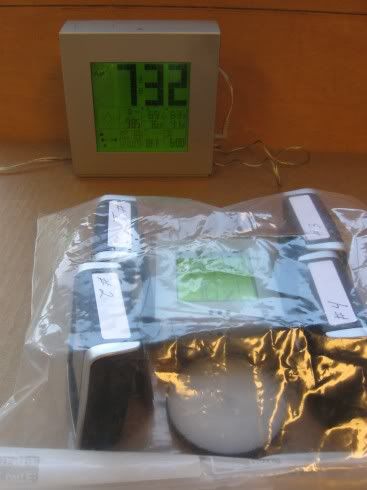 After testing 4 units I chose to place #1 on the top shelf, #2 on the bottom and #3 in the middle. Based on the salt test the remote unit and #3 are 1% high and unit #1 & #2 are dead on.  Since I used Excel to keep my charts, all my charts online will show the adjusted results and will already be adjusted for the remote and #3 being off. All test results are double checked by an independent, unbiased (and somewhat uninterested) expert in temperature and humidity science: Buster!  For my moisture source I am using Scott Shilala's Beads. In various locations I have 4 - 8oz pouches and 2 - 2oz pouches for a total of 36 ozís. |

|
|
|
#2 |
|
Guest
Posts: n/a
|
Part 2 - Day One
No power to unit, no fans inside The desired outcome for day one was to demonstrate the stability of the unit in a relatively cool environment. The unit was in a room where the temperature only fluctuated between 65 and 71 degrees. During this test the vino was never opened and the unit was unplugged with no circulation. As you can see, there was some fluctuation of the RH. As the temperature rose in the middle of the day, the RH inside the unit fell. After 2pm the top saw the most rapid change while the middle, the bottom and inside the box saw a much slower change. The interesting part was after midnight as the temperature fell, the RH rose again. Notice the change in the middle and inside the box, the middle stayed the same and inside the box dropped another 1% while the top and bottom rose 2%. Here are the results: 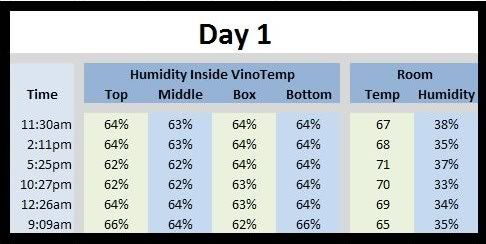 And a few shots of the test throughout the day:  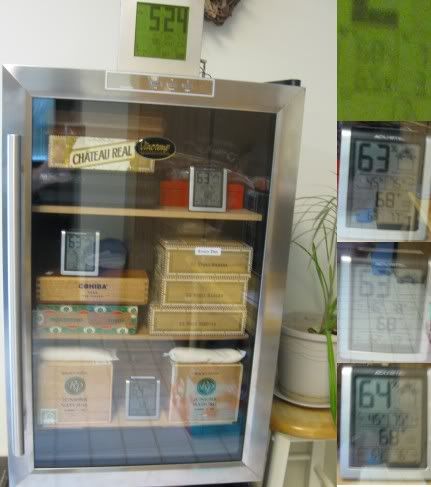 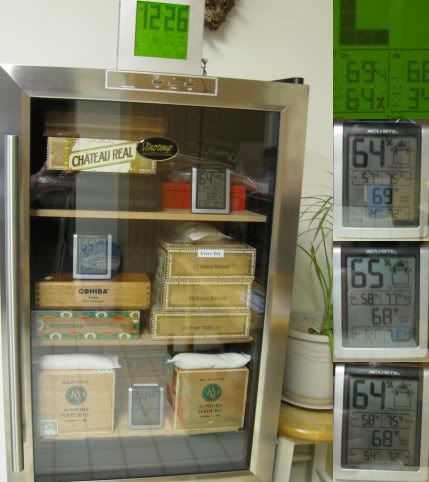 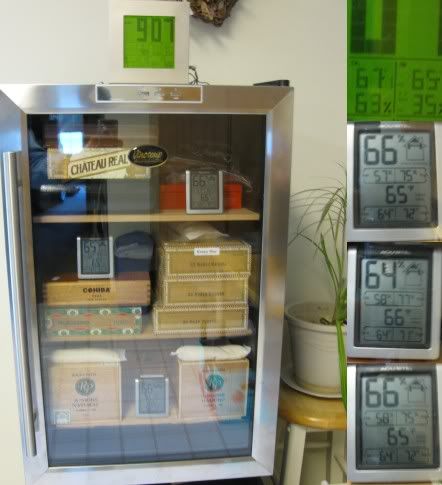 I repeated this test on day two with almost identical results. Up next; I placed an Oust fan in the unit. |

|
|
|
#3 |
|
Guest
Posts: n/a
|
Part 3 - Day Three
Still no power to the unit but I placed an Oust brand fan on the top tray facing the front glass. In theory when the fan runs, it should move air from the top of the unit and spread it out over the whole front of the unit. I thought it might be somewhat inaccurate since the air would be blowing over the same area where the Acu-Riteís were placed, but the front is where the largest continuous free space is located so I figured itís where I would get the best circulation. Day three also saw a larger rise in room temperature than day 1 and 2. The temperature went from 68 to 76 degrees before dropping again. The readings at 7:30 am are before I put the fan in. The door was opened less than 5 seconds to place the fan. Like the previous 2 days, the RH generally fell as the temperature rose except inside the box and the middle. The 69% reading on the bottom at the end of the 24 hour period is very weird. I will let each one compare the results and draw their own conclusions on whether the fan made any difference or not. Perhaps it did, but the stability would appear to be about the same to me. Here are the results: 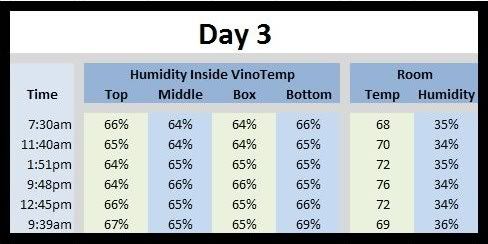 And a few shots of the test throughout the day: 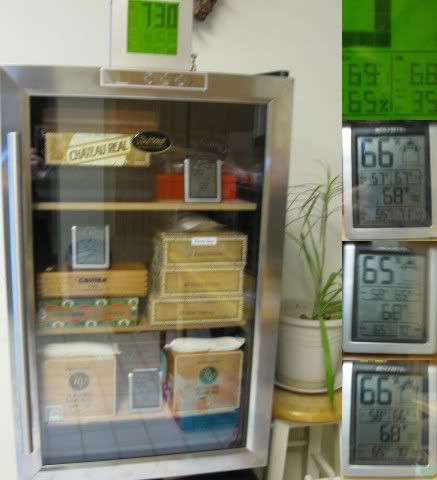 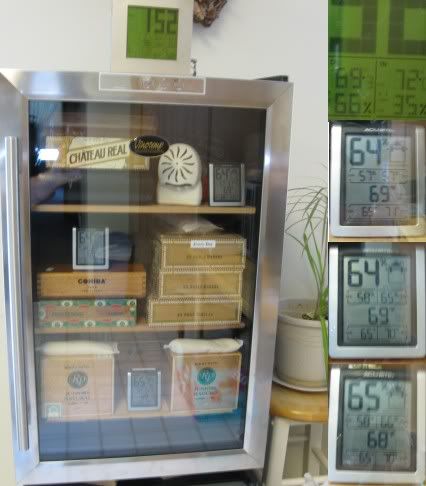 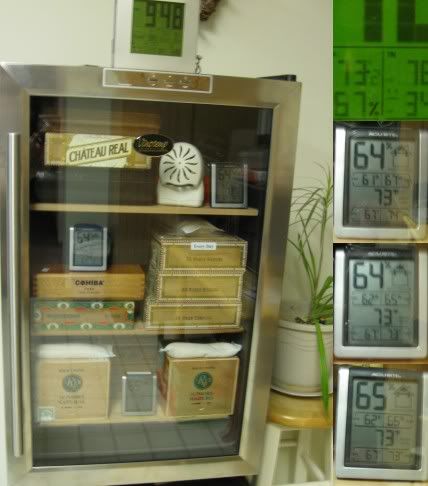 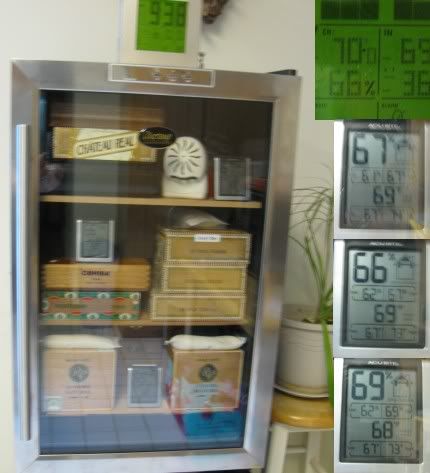 Up next; Plugging in the vino and testing the swings while it cycles. I donít have all the photos edited yet, so it may be a few days for the final part so bear with me. Itís taken me almost a week to get this much done and my stitches finally came out today. Chas |

|
|
|
#6 |
|
Guest
Posts: n/a
|
Great stuff! Looking forward to the remaining results!
|

|
|
|
#7 |
|
Dear Lord, Thank You.

|
I'm excited to see all your data. Thanks for sharing, Chuck!!!
 So far, all I can remark is that oust fans don't move enough air to make a difference. At all. Period. In a cooler, they're great. That's cause a cooler never gets opened and closed. It's a whole different animal. When the peltier kicks on, or the evaporator kicks on in any cooler/vino, the humidity will drop rapidly. It's supposed to. (Your results are going to show that.) That's because the water in the air is condensed on the cooling element. Once the fan dries that water from the element, it'll return the water to the air, and you have a zero loss/gain of water in the humi. A net aggregate zero loss/gain. That's what we're after. If a guy doesn't plug his drain or the humi leaks, all bets are off. That's why vinos are so awesome for keeping cigars. They don't leak.  Some day I'll put a refrigeration cycle as it pertains to our hobby in picture/web format. It's so simple. It'd help so much. I'm just too busy convalescing and chasing wild women. 
__________________

|
|
|

|
|
|
#8 |
|
Guest
Posts: n/a
|
Part 4 - Day Four
This is the day I turned on the power to the Vino for the first time. Since there is no on/off switch just a temperature controller and I wanted to simulate short cycles rather than it running all the time I just plugged it in and unplugged it. The first 2 readings, 9:39am and 1:09pm were done without any power to the unit yet. I plugged the unit in right after the 1:09 reading and let it run for 1 hour and unplugged it. The 2:52 reading represents the point where the Vino began to stabilize and a few of the numbers had actually began to come back up. Over the next 5 hours you can see from the numbers all the readings inside the unit continued to rebound. At 8pm I plugged the Vino back in. As you can see from the next reading, the RH inside the Vino began to drop again. An interesting trend to watch was that of the RH inside the box. Like the previous day, the RH inside the box gradually rose as the temperature rose. While the RH inside the Vino fell rapidly in the afternoon, the RH inside the box only fell 3% and then climbed right back up to 66%. It did not begin to fall off again until after the 6pm reading. While the Vino experienced RH swings in excess of 15%, the box only saw a swing of 3%. Here are the results:  And a few shots of the test throughout the day: 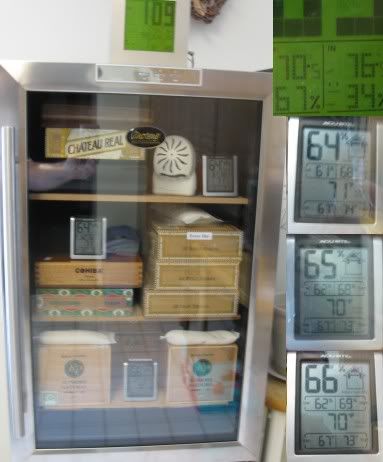 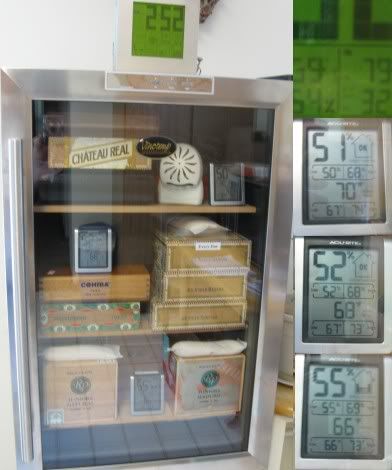 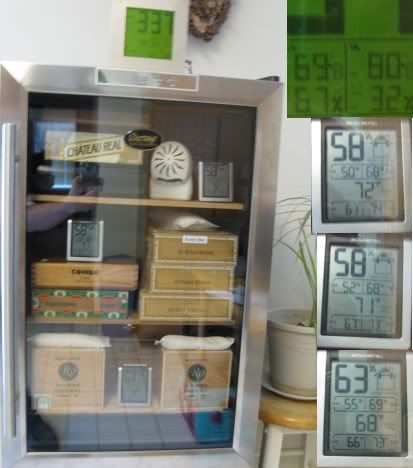  Conclusion: The purpose of the test today was to illustrate the instability I noticed in my unit on those days where the unit cycles on and off repeatedly. Here in the northeast I noticed these swings at the beginning and end of our cooling season. In the heat of summer when the unit is running more than itís off, the unit stabilizes much faster, and maintains itís RH. As I type this the unit has been plugged in for over a week and is as stable as it was during the first 2 days of this test. I donít think I have walked past it lately and not heard it running. Itís my contention that rapid swings I noticed could not be good for my cigars. I therefore keep everything in boxes, and thatís why I offer trays with tops. Some people report they have never seen the swings I have demonstrated here, others have. My suggestion to anyone who owns a cooled unit, buy a device that will track the highs and lows over a 24 hour period and check your conditions. The Acu-Rite Humidity/Temperature Monitors, even if not accurate when salt tested, will show you the ďswingĒ. The middle unit in this test showed a swing in RH from 52% to 68% at 8am the following morning. Many factors will determine your own results. The amount and quality of your beads will also determine how fast the unit can bounce back. Circulation in the unit to evaporate the condensation back into the air will also be a key. In closing may I pose this final question; you have how much invested in all those cigars and paraphernalia? It cost less than $10 bucks to check this out using an Acu-Rite. Itís like high blood pressure; sometimes itís too late once you realize you have a problem. Thanks for reading, Chuck |

|
|
|
#9 |
|
Ditat Deus

|
Chas thank you for confirming with evidence what I was seeing in my Edgestar. I had been storing my cigars in open trays from old humidors but the swings in humidity worried me greatly. I recently bought some larger stackable trays from Target to better protect the cigars. Kinda the poor man, quick solution to your trays, which I can't wait to get.

|
|
|

|
|
|
#12 |
|
Just plain insane!
|
Thanks for a great job!!
|
|
|

|
|
|
#14 |
|
That's what she said
|
Your results are interesting.
I have my vino plugged in from Spring to Fall, and the drain plugged. 1.5 lbs of beads on the bottom of the vino. My vino stays ROCK solid @64% and 67-68*. I never saw you mention if you had sealed up your drain hole in the vino? I also ran wires through my drain hole and have a computer fan on a timer to help circulate air inside (unnecessary, but a fun little project)
__________________
The Dude abides |
|
|

|
|
|
#15 | |
|
Guest
Posts: n/a
|
Quote:
You probably don't see the same results because: A.) the vino is probably running more than its off, B.) You have sufficient beads to compensate for the swings and C.) Mainly the fan. Although you feel its unnecessary, I feel you could not be further from the truth. The reason for the drops is when the unit cycles it pulls moisture out of the air and it condensates on the unit and drips down the back wall if there is sufficient moisture. The goal is to accommodate for this natural process and get the moisture back into the air as fast and efficiently as possible. With good circulation, fast reacting beads and a good seal, this can be done quickly. Like I said at one point in the post, I only see these swings when the unit is running less than 1/2 the time. That's why I simulated short cycles. I just checked my vino, has been plugged in for several weeks, I believe, 10 days for sure, and the swing over the last 24 hour period was 6%. Right now its running almost all the time since I have the Ac turned off and the room temp gets to almost 80 during the day and less than 70 at night. Chas |
|

|
|
|
#17 |
|
Have My Own Room
Join Date: Jul 2009
First Name: Dave
Location: Lake of the Ozarks & Austin, TX
Posts: 1,333
Trading: (3)
 |
Thanks for sharing your research project with everyone, very interesting. In the last post you mentioned "quantity and quality of beads". I am shopping for beads for my new Edgestar and found a number of suppliers with great price differences. I have heard many people refer to Heartfelt which are rather expensive and would appreciate it if others would share their knowledge on beads, are they all similar and where is the best value? Like you said it is not worth $10 to damage a $1000 worth of stogies.
|
|
|

|
|
|
#18 |
|
Guest
Posts: n/a
|
A bump for my brother!
|

|